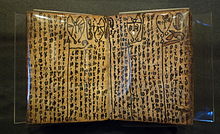What Is The Historical Backbone Of The Writing System Throughout Eastern Asia

A manuscript from the early 1800s from central Sumatra, in Batak Toba language, one of many languages from Indonesia.
There are various non-Latin-based writing systems of Southeast Asia. The writing systems below are listed by language family.
Austroasiatic languages [edit]
- Khmer script (for Khmer language)[1]
- Khom script (for Bahnaric languages)[2]
- Chữ Nôm (historical writing for Vietnamese language)[3]
- Mon script (for Mon language)[4]
Austronesian languages [edit]
Most Austronesian languages use Latin script today. Some non-Latin-based writing systems are listed below.
- Jawi alphabet (for Malay and a number of other languages)[5]
- Cham script (for Cham language)[6]
- Eskayan script (for Eskayan language)[7]
- Kawi script (used across Maritime Southeast Asia)[8]
- Balinese script[9]
- Batak script[10]
- Baybayin[11]
- Buhid script[12]
- Hanunó'o script[13]
- Kulitan alphabet (for Kapampangan language)
- Tagbanwa script[14]
- Javanese script[15]
- Lontara script[16]
- Makasar script
- Old Sundanese script
- Sundanese script[17]
- Rejang script[18]
- Rencong script
- Buda script
Hmong-Mien languages [edit]
- Romanized Popular Alphabet (Hmong RPA)
- Pollard script[19]
- Pahawh Hmong[20]
- Nyiakeng Puachue Hmong
- Eebee Hmong
Kra-Dai languages [edit]
Many Southwestern Tai languages are written using Brāhmī-derived alphabets. Zhuang languages were traditionally written with Chinese characters, but are now usually written with romanized alphabets.
- Thai script[21]
- Lao script[22]
- Sawndip
- Shan script[23]
- Tai Viet script[24]
- Tai Le script[25]
- New Tai Lue alphabet[26]
- Tai Tham script[27]
- Tai Yo script
Tibeto-Burman languages [edit]
- Burmese alphabet[28]
- S'gaw Karen alphabet
- Ersu Shaba
- Kayah Li alphabet[29]
- Fraser alphabet[30] (used to write the Lisu language)
- Naxi script[31]
- Geba syllabary
- Dongba symbols
- Zomi script
- Tangut script[32]
- Tibetan script[33]
- Tujia script[34]
- Yi script[35]
See also [edit]
- Classification schemes for Southeast Asian languages
- Writing systems of Africa
References [edit]
- ^ Omniglot. Khmer. Retrieved 19 March 2019.
- ^ Sidwell, Paul. (2008). The Khom script of the Kommodam rebellion. International Journal of the Sociology of Language, 2008(192), 15-25.
- ^ Omniglot. Chữ-nôm script. Retrieved 19 March 2019.
- ^ Omniglot. Mon. Retrieved 19 March 2019.
- ^ Omniglot. Malay (Bahasa Melayu). Retrieved 19 March 2019.
- ^ Omniglot. Cham. Retrieved 19 March 2019.
- ^ Omniglot. Eskayan. Retrieved 19 March 2019.
- ^ Omniglot. Kawi alphabet. Retrieved 19 March 2019.
- ^ "Balinese alphabet, language and pronunciation". Omniglot.com. 2008-04-16. Retrieved 2014-05-12 .
- ^ "Batak alphabet". Omniglot.com. Retrieved 2014-05-12 .
- ^ "Tagalog alphabets, pronunciation and language". Omniglot.com. 2007-12-24. Retrieved 2014-05-12 .
- ^ "Buhid/Mangyan alphabet". Omniglot.com. Retrieved 2014-05-12 .
- ^ "Hanunó'o alphabet, language and pronunciation". Omniglot.com. Retrieved 2014-05-12 .
- ^ "Tagbanwa alphabet and languages". Omniglot.com. Retrieved 2014-05-12 .
- ^ "Javanese alphabet, pronunciation and language (aksara jawa)". Omniglot.com. Retrieved 2014-05-12 .
- ^ "Lontara script". Omniglot.com. Retrieved 2014-05-12 .
- ^ "Sundanese language, script and pronunciation". Omniglot.com. Retrieved 2014-05-12 .
- ^ "Rejang alphabet and language". Omniglot.com. 2009-12-31. Retrieved 2014-05-12 .
- ^ "Pollard Script". Omniglot.com. Retrieved 2014-05-12 .
- ^ "Hmong language, alphabets and pronunciation". Omniglot.com. Retrieved 2014-05-12 .
- ^ "Thai language, alphabet and pronunciation". Omniglot.com. Retrieved 2014-05-12 .
- ^ "Lao alphabet, pronunciation and language". Omniglot.com. Retrieved 2014-05-12 .
- ^ "Shan alphabet, pronunciation and language". Omniglot.com. Retrieved 2014-05-12 .
- ^ "Tai Dam alphabet, pronunciation and language". Omniglot.com. Retrieved 2014-05-12 .
- ^ "Dehong Dai script and language". Omniglot.com. Retrieved 2014-05-12 .
- ^ "New Tai Lue script". Omniglot.com. Retrieved 2014-05-12 .
- ^ "Lanna alphabet (Tua Mueang)". Omniglot.com. Retrieved 2014-05-12 .
- ^ "Burmese/Myanmar script and pronunciation". Omniglot.com. Retrieved 2014-05-12 .
- ^ "Kayah Li / Karenni alphabet". Omniglot.com. Retrieved 2014-05-12 .
- ^ "Fraser alphabet". Omniglot.com. Retrieved 2014-05-12 .
- ^ "Naxi scripts (Dongba, Geba and Latin) and language". Omniglot.com. Retrieved 2014-05-12 .
- ^ "Tangut script and language". Omniglot.com. Retrieved 2014-05-12 .
- ^ "Tibetan alphabet, pronunciation and language". Omniglot.com. Retrieved 2014-05-12 .
- ^ "Tujia language, alphabet and pronunciation". Omniglot.com. Retrieved 2014-05-12 .
- ^ "Yi script and language". Omniglot.com. Retrieved 2014-05-12 .
What Is The Historical Backbone Of The Writing System Throughout Eastern Asia
Source: https://en.wikipedia.org/wiki/Writing_systems_of_Southeast_Asia
Posted by: henrickshielturry.blogspot.com

0 Response to "What Is The Historical Backbone Of The Writing System Throughout Eastern Asia"
Post a Comment